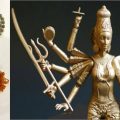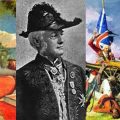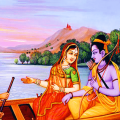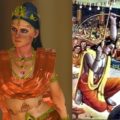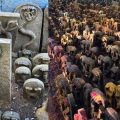Allegorical Interpretation of Draupadi’s Abuse and other Myths
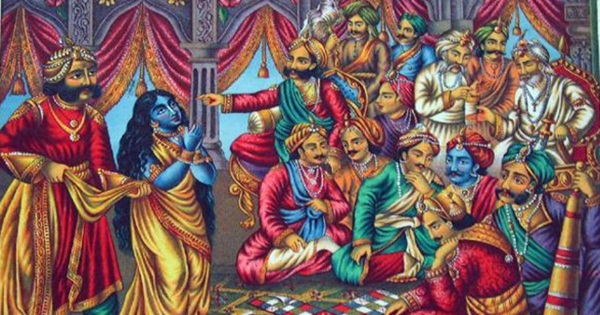
Vedic people had long life spans and were taller and stronger in general. Kshatriyas were the protectors and defenders. But they were not necessarily philanderers. They were trained by rushis and so their level of maturity was much higher. Arya means noble. The word kshatriya describes spiritual warriors of a very high calibre so even the mistakes that they made are of a higher calibre as compared to ordinary people, especially of kaliyug. These stories can be read as allegorical and a parabole with double layers of meanings; one worldly the other spiritual, although both intertwine. Also many names can be read as descriptive nouns which describe the person’s characteristics. For example, Arjuna is also called Parth, Kaunteya and Dhananjeya.
We all know about the devastating effects of deadly bombs, for example, on Japan in WWII. If the weapons described in the Mahabharat had been really used could the planet or even the solar system have survived? There are records of radiation in areas of modern Kurukshetra and of people having been born with defects. So it could be that there was a deadly war, but it may not have been the one referred to in the Gitaji. Or, maybe the war happened much earlier so the earth had sufficient time to rejuvenate and start sustaining life. Maybe it was a war of words with both parties demonstrating their knowledge. It could be a mantric war in astral planes or Hiranyaloka as mentioned in ‘In Autobiography of a Yogi’ by Paramhamsa Yogananda. Or, an allegory, as mentioned in E.Washburn Hopkin’s ‘Yoga Techniques in the Great Epic’. He writes that yoga is a war-car in which the yogin, once equipped, gets victory. The chariot-guards are known as prsthagopas and parsvagopas. And elsewhere, ‘prstharaksas’. Yoga in camp parlance is ‘harnessing up’. Gopas are the guards and not poor cowherds. ‘Go’ means pruthvi, both inner and outer. Cows help in maintaining eco-balance among other things which is why they are venerated. Even raksas probably meant one who does raksa or protection, not a demon.
Krushna bhakti is about activating chakras. The word can be broken into Kru=to do, create karmas+Ushna = sun’s heat. It means NirdosapratibhaKrisna or complete faultless illumination achieved by yogis. Krushna was killed by an iron arrow. Properties of iron are damaging to our chakras and also the earth. This could imply the dying of the divine power on earth due to excess use of environmentally damaging products and the unhealthy lifestyle of society. As predicted in Vedic texts people gradually deteriorated and their level of understanding, perceptions and values changed.
Draupadi was known as Krushnaa, supposedly had five husbands, was gambled away and molested by Kauravas. But there are scholars who claim otherwise. Pradip Bhattacharya says that it is a later interpolation and has provided evidence that can be read on the internet. Even the Puranas don’t refer to this incident. In his book ‘The Cult of Draupadi’ Alf Hiltebeitel discusses how various cults had their own interpretations. In south India Draupadi was believed to be an incarnation of Mahakali, born to assist Krushna to destroy the arrogant rajas. All ancient tales have been rewritten numerous times. A lot can get lost in translation and connotations change. Allegorically Kauravas could represent temptations faced by yogis. Hopkins mentions:
‘Devoted to severe austerities, Pandu stood on one foot all day with the most extreme concentration, Samadhi.’ And, ‘A girl, on being brought out to elect a husband at her election-ceremony, ” chooses as husband the forest,” and becomes an ascetic, with fasts, diksas, and restraints, niyamas; all as tapas (tepe).’ And ‘……..restraint of tongue, mauna, excessive torment, ativatopas, and “drying up the body” by various means, both in the case of saints and ascetic kings.’
One example of the above would be Parvati. The word could be broken into ‘para’ or higher Brahman and ‘vati’ meaning path. Thus, she chose to ‘marry’ Siva, or the goal of uniting with the divine, who is not a man. Another was Ahalya who didn’t like being (symbolically) molested by her Indra and so became ‘Sila’ (good conduct), and immovable or determined as a stone, (not literally), did intense tapas for thousands of years and got divinised. Even Ramayan has a double meaning. Indra was not a man but the power behind our right eye. When a yogi/yogini succumb to this power they have various experiences which they don’t want as it hinders their progress.
In those days swayamvars were not about people competing for the girl like a medal. They were social events, business was done, alliances made and broken etc. But the basis for these was spirituality rather than money. Society in those days was cashless and martial. The word could be broken into ‘swa’=self, ‘yama’=brahma gyan, ‘var’=acceptance. Or, swayam+var.This would mean the girl tests candidates in level of brahma gyan and accepts one. Draupadi was fire-born implying rajasic. Or, that she had been through the fire of tapas. Being kshatriya means she too was a trained warrior. Pandavas had ‘disguised’ themselves as brahmans. This would be a little difficult because everyone wore dhotis and had long hair. Brahmans started shaving only much later in kaliyug. Since hair style was so important it is unlikely that the Pandavas would have shaved their heads just for the occasion since it would take time to grow it long again. One way of reading this would be that they behaved like brahmans. This proves that Draupadi was not greedy for power and quite happy to live a simple life. A kshatriya’s lifestyle was like that of a kung-fu monk, to give an example. They were accustomed to austerities and hard work. And there is no reason to believe that she would not be allowed to pursue her swadharma of doing kshatriya duties such as to protect and serve the masses since there was no discrimination.
‘AhalyaDraupadiSita Tara Mandodaritathapanchakannasmarenityammahapatakanashanam.’
This sloka has another version using the word ‘panchkanya.’ Panchakanna has been translated as mahasatis in ‘PrarthnaPriti’published by SvadhyayParivar, and panchakanya means virgins. Sati means being an accomplished tapasvi, so necessary to be a celibate. So how can they be married? They were also known as Mahisi, or chief queen (but not necessarily married to raja). Duties of Mahisi and Mahisa, the raja, also included doing yagyas, for which mantra siddhi was required to make the mantras manifest. This required intense tapasya and yoga and bhoga don’t go together. This is demonstrated in stories of various Mahisa, Mahisi and Asuras who meditate on devis/devatas who come to destroy them. But, these have been misinterpreted. ‘Asusuramateitiasurah’. This means one who indulges in sense objects is known as an asurah. Thus, they were not necessarily a tribe of demons.
After intense tapasya the divine would ‘kill’ their gross body desires, or maybe if they had reached end of their vasanas their soul would depart. Or, they could continue existing in different dimensions like svarga, or without body. Such siddhis have been discussed in various books. This clearly tells us that Mahisa and Mahisi are not buffaloes. The word may have been used as a metaphor for strength, and in context of Yama whose vahana is buffalo. Yama is not the ‘god of death.’ He gives the sadhak Brahma gyan. The word is reverse of Maya (as explained by PandurangShastriAthavale) and signifies a tapasvi’s level of detachment from maya. And, Mahisa and Mahisi are conceptually connected to Mahesh and the holy river Mahi.
Swayamvars were probably about a Mahisi selecting her Mahisa or dharmic partner, which implies that they must have been superior and that their government had a women’s wing. ‘Pati’ was used in context of Kulapati, Pashupati, Ganapati. This is why even Mirabai says that Krushna is her pati, (not actual husband). This was indicative of her spiritual state. So, when the other Pandavas too ‘fell in love’ with Draupadi, chances are that they were impressed by her powers and wanted her to be their Mahisi too and not wife. Each was a Mahisa and specialised in particular yagyas, whereas Draupadi probably specialised in all and could empower them, just like a battery. Draupadi is said to have lived with one Pandava each year. This was probably necessary in order to get their mantras synchronised. Draupadi can be broken as; Drau=courage; Pa=ruling/protecting and Dhi=intelligence/contemplation/imagination. Pandavas are ‘wedded’ to these qualities, and Kauravas covet them.
Yagyas involved many personnel including women who accompanied the mantras with Veenas and were known as Vainikas. There were various levels and roles within this framework which is why often one finds rajas and rushis having many women on their teams, but this has been wrongly interpreted as them being wives. Some words like Jaya, Amba, Ambika, Ambalika etc. could be common nouns for the position they held rather than their names.
The meaning of AkshaVidya from the dictionary is:
Aksha -[from the verbal root aksh, to reach, pass through, pervade], a die for gambling, a cube, inner knowledge, as the axis or pivot of life.
And this passage from the Mahabharata, AranyaParva second chapter says:
“Bahuka! This is calculus, a mathematical science. I will teach you.” So saying Rutuparna taught AkshaVidya to Bahuka. In return Bahuka offered to teach AsvaHrudaya but Rutuparna said that he will learn it later. With the influence of AkshaVidya, the influence of Kali was vanished.”
If akshavidya means calculus and also refers to all pervading inner knowledge, then, calling it a game of chance would be a figure of speech. The situation probably involved testing rajas in all branches of knowledge and their ability to govern. Yudhisthir put forward each candidate to compete in their area of speciality. Every time one of them lost it implied that they lost the right to govern, not literally the human. There is no evidence of slavery in those days. Above passage also tells as that ‘asva’ is used in context of high level knowledge involving Surya as mentioned by many scholars.
There is also ample evidence to suggest that many ancient societies were matriarchal. Vedic society was the most ancient and there are records of women rishis, example, Roma, Gargi, Ahalya, Lopamudra etc. Women probably specialised in other fields too such as psychological warfare, toxicology etc. since in an actual war it would be difficult to fight and win against more muscularly endowed men. Thus, Draupadi could very well have been a commander of the Pandava government. And since Draupadi was close to her inner divine, (Krushna), one can safely conclude that she was highly advanced.
Draupadi’s area of expertise could have been non-violent combat or even law. She said she refused to accept defeat since she had not yet had the opportunity to compete. In those days if a soldier was not happy with the outcome of war, he could challenge the winners to a duel. So, she tried to sway Bhisma and the others with her arguments. In the meantime, Dushana was pulling at her cloth, or duppatta which was usually worn as a badge of honour and position, just like a turban. This could be symbolic. When one sees ancient paintings and sculptures, women are seen wearing dhotis, cholis and dupattas, not saris. We can’t assume that Draupadi was wearing one if it was not the norm. Krushna returning her cloth probably means that she manages to argue her case and win. Also, when they are taunting her, it could be as a professional, and not as a woman. They failed to metaphorically expose her. Many feel that Krushna could have prevented the war (if it was a physical war). But this is wrong because the divine is an invisible power just like electricity and manifests via spiritual people. Krushna is jagatguru and his job is to guide people on their karmic path rather than do all the dirty work for them. The aim of spiritual warriors was to attain enlightenment via karmas.
In those days the guru shishya tradition was very strict. Since Duryodhana was Balabhadra’sshishya it’s doubtful that he would risk losing reputation just to indulge in malice and also not get punished by Balabhadra, who was not a Kaurava stooge. He would not have chosen Duryodhan’s son as his son-in-law if they were so bad. So we may conclude that Kauravas, who too were high class warriors, were not molesting Draupadi. They probably wanted her to be their junior and would keep her in their lap metaphorically, or in other words favour her or go easy on her. The word Dasi does not mean slave since they had rishis to keep them in check. But Draupadi found it insulting since she was a Mahisi/commander and they were asking her to change alliances. Pandavas had already been demoted so they could not oppose their seniors because kshatriya society was a military organisation with similar rules. Maybe, Kauravas were deliberately testing and provoking Pandavas to react. This also tells us that Pandavas were asking to be allowed to govern, which was their swadharma, and not demanding their kingdom, since in those days people didn’t own kingdoms.
When Duryodhan slaps his thigh it could be that he is challenging Draupadi the way most kushti practitioners do. Ancient fighting skills included marmavidya which involved use of nerve centres and nodal points to disarm the enemy. The inner thigh was a very vulnerable area for Duryodhana, which is evident since Gandhari wanted to use her spiritual shaktis to strengthen it. She asks him to go to her without clothes but is adroitly dissuaded by Krushna. Could it maybe mean that Duryodhan is more susceptible to the apsara-shaktis that emanate from thighs of advanced yogis?
Shakuni’s cheating could also be read as a metaphor. Shakuni, which is an astrological term, is in Kaurava’s astrological charts or house, bringing them luck. Even Bhisma had pledged to support Hastinapur’s ruler and was not their puppet. He was a bully (which is adharma), because he kidnapped Amba, Ambika and Ambalika. At the swayamvarAmba had already chosen her partner, which is why she pledged to teach him a lesson.
It would also be wrong to say that Satyavati was a ‘low caste’ woman since there was no caste system. Varnashram was about spiritual and karmic calibre. Also, she is said to be a matsyakanya which doesn’t translate as fisherwoman. Kanya means virgin. Matsya relates to knowledge as can be seen from MatsyaPurana. Fish is a metaphor used for the spark of consciousness that swims in bhavasagar and inner ksirsagar. It also refers to the Ajna chakra associated with the third eye on the forehead and the pineal gland which regulates the circadian rhythm, and also an actual light-sensitive ‘third eye’ (Parietal eye) found in some lizards, amphibians, and fish. (This is the fish’s eye that Arjun could pierce). It is also sometimes associated with the pituitary gland, the master of all endocrine glands, whose secretions control all the other endocrine glands.
It also appears that all the main problems faced by the Pandavas are almost exactly like those faced by advanced aspirants on the path to enlightenment. Such as: 1) Vanavas 2) Draupadi’schirharan 3) Draupadi’s hair being pulled when Dushasana drags her. 4) Duryodhan slapping thigh, which is reminiscent of Narayan slapping thigh to produce Urvashi the apsara.
1)Vanavas was done to weed the inner and outer forest. There are numerous stories of people doing this, such as Mandalsa who sent her sons to do vanavas. Being a raja was not always about literally enjoying material wealth and since asramas and gurukuls were where the entire population got educated, how could it be a punishment?
Dr. SubhashKak in ‘The Asvamedha – The rite and its Logic’ mentions:
‘The king obtains his power from the aranya where the asramas of the gurus are located, and where also reside wild and dangerous animals and people. The aranya is full of danger and opportunity. The king must build his strength in the aranya to be able to rule the grama. We see this pattern in the travails of Rama and Yudhisthira.’
The Abhidharma-mahavibhasa-sastra, a Sarvastivadin commentary gives the meaning of Vana as the path of rebirth and also means dense forests of the five aggregates (panchaskandha), and three roots of greed, hate and delusion which need to be cleared. The second chapter of AranyaParva also mentions that when the Pandavas went to the vana they had with them all their chariots. The word ratha can also be read as dharma carrier; derived from Rta or universal dharmic law.
2)Chirharan can’t mean stealing of clothes, just the way ‘chir-pravasi’ does not mean clothes are travelling. Nor does Hari Haran mean that hari is being stolen. It probably means the bhakta is losing mind-consciousness and then gets darshan of Sri Krushna, who is known as chit-chor. Also, in Hindi one says ‘chir Haran hogaya’ which can mean that chir (body) has become Hara (Sivmaya). Losing clothes could also mean becoming Digambar. The metaphor of clothes for body is used often. For example, when explaining how the soul changes bodies the way body changes clothes. Many bhajans too mention this. Example, ‘mailichadariyaodhkekaisedvartumhareaaoo…’ Here chadariya does not refer to actual blanket.
Krushna clothed Draupadi in yellow and white clothes. This could mean that the mooldhara chakra was awakened, since those are the colours of that chakra and symbolise spirituality and courage. Gouri means woman with yellow and white complexion. So this could imply that Draupadi’s inner ‘complexion’ changed and she reached state of Parvati/Gauri since her kundalini had activated. Just like Arjun’s who gets Yogesvardarshan on Kurkshetra.
3)Yogic texts mention that a feeling like that of hair being pulled is experienced when divine consciousness awakens. Swami Yogananda says that head has more hair because that is where the seat of energy is. Like an upturned plant, man absorbs through his hair electric currents helpful to the body. This is probably what happened when Dushasan pulls Draupadi’s hair. Her adversity motivated her to become highly spiritualized and she had a kundalini experience. Then, when she pledges never to tie her hair it does not necessary imply that she wants revenge. It could mean that just like Chanakya she worked hard to remove evil from society by doing intense tapas.
4)‘Ap’ means water and ‘sara’ means essence. We have numerous rivers of energy inside us which when divinised, give various siddhis. These are probably the apsaras (not women), that seduce tapasvis who sometimes indulge in these powers. Narayan is the divine and it’s unlikely that he would slap thighs to produce glorified prostitutes to seduce men. This probably refers to spiritually developed inner thighs of suksmasarira which have specific chakras.
Some say that Duryodhana’s original name was Suyodhan. Did it change due to his behaviour or in later years due to people’s misunderstandings? Could that also be the case with other names and stories? Mahabharat is a patchwork of historical and dharmic information and taking things too literally can be detrimental to our education.
HARI AUM
Featured image courtesy: Livemint

